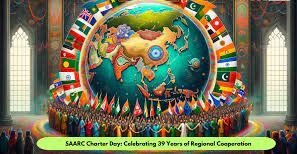Celebrating 39 Years of Regional Cooperation on SAARC Charter Day
The South Asian Association for Regional Cooperation (SAARC) celebrates its Charter Day on December 8th, marking 39 years of fostering regional collaboration among member nations. This commemoration highlights the organization’s founding principles and its ongoing commitment to fostering cooperation and development across South Asia. Established in 1985, SAARC aimed to promote economic growth, social progress, and cultural development among its eight member states, namely Afghanistan, Bangladesh, Bhutan, India, Maldives, Nepal, Pakistan, and Sri Lanka.

Why this News is Important
- Regional Cooperation: SAARC Charter Day signifies the importance of cooperation among South Asian nations, fostering unity and shared progress.
- Economic Growth: It emphasizes the collective efforts towards economic development, trade facilitation, and poverty alleviation within the region.
- Cultural Exchange: Celebrating the Charter Day underscores the promotion of cultural exchanges, fostering understanding and harmony among member nations.
Historical Context
The inception of SAARC can be traced back to the late 1970s when the concept of regional cooperation gained momentum in South Asia. The idea was to enhance mutual understanding and address common issues faced by the countries in the region. Consequently, the First SAARC Summit took place in Dhaka in 1985, where the member nations signed the Charter, outlining the objectives and principles of the organization. Since then, SAARC has served as a platform for dialogue and collaboration in various fields, including agriculture, trade, education, and healthcare.
Key Takeaways from “SAARC Charter Day”
| Serial Number | Key Takeaway |
|---|---|
| 1. | SAARC celebrates its 39th Charter Day on Dec 8th, emphasizing regional cooperation. |
| 2. | Member nations include Afghanistan, Bangladesh, Bhutan, India, Maldives, Nepal, Pakistan, and Sri Lanka. |
| 3. | The organization aims to promote economic growth, social progress, and cultural development. |
| 4. | Challenges include addressing poverty, terrorism, and climate change collectively. |
| 5. | SAARC provides a platform for dialogue and collaboration in various fields among member states. |
Important FAQs for Students from this News
What is the significance of SAARC Charter Day?
SAARC Charter Day marks the anniversary of the establishment of the South Asian Association for Regional Cooperation (SAARC) and highlights the importance of regional collaboration among member nations.
How many member nations are part of SAARC?
SAARC consists of eight member states: Afghanistan, Bangladesh, Bhutan, India, Maldives, Nepal, Pakistan, and Sri Lanka.
What are the objectives of SAARC?
SAARC aims to promote economic growth, social progress, and cultural development among its member nations. It serves as a platform for cooperation in various fields, including trade, agriculture, education, and healthcare.
What are the common challenges faced by SAARC member nations?
SAARC member nations face challenges such as poverty, terrorism, climate change, and socio-economic disparities, which require collective efforts for resolution.
How does SAARC contribute to regional development?
SAARC facilitates dialogue, collaboration, and diplomatic relations among member countries, fostering unity and addressing common issues for regional development and progress.
Some Important Current Affairs Links


















